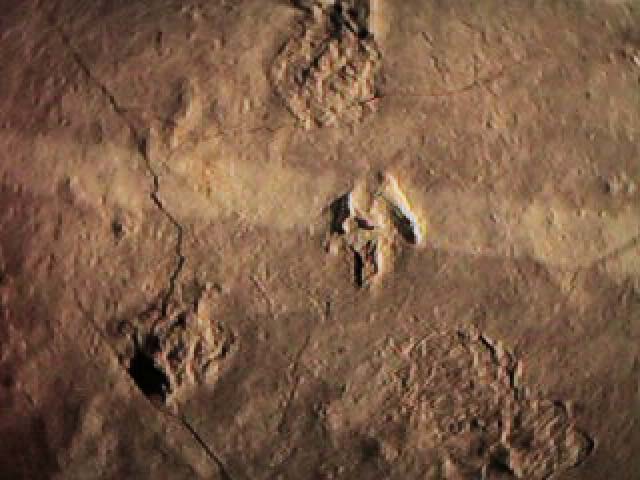Activities: trackway math problems
 If you know a little about a dinosaur’s footprint, you can use some math to
learn much more about the dinosaur’s size and speed.
If you know a little about a dinosaur’s footprint, you can use some math to
learn much more about the dinosaur’s size and speed.
Try some of the examples here, based on real dinosaur data.
Here are the math formula to use:
Hip Height = 4 x Footprint Length
Head-To-Tail Length = 10 x Footprint Length
Stride Length ÷ Hip Height = less
than 2.0 means the dinosaur was walking
Stride Length ÷ Hip Height =
between 2.0 and 2.9 means the dinosaur was trotting
Stride Length ÷ Hip Height =
greater than 2.9 means the dinosaur was running
 1.
Among the longest dinosaurs was Ultrasaurus. If an Ultrasaurus
footprint was 3.1 meters long, what were its hip height and its head-to-tail
length?
1.
Among the longest dinosaurs was Ultrasaurus. If an Ultrasaurus
footprint was 3.1 meters long, what were its hip height and its head-to-tail
length?
 2.
One of the smallest dinosaurs was Compsognathus. It was only about 76
centimeters from head to tail when it was fully grown. What would be the length
of its footprint?
2.
One of the smallest dinosaurs was Compsognathus. It was only about 76
centimeters from head to tail when it was fully grown. What would be the length
of its footprint?
 3.
One of the fastest dinosaurs was Gallimimus. When it reached its running
speed of 35 miles per hour, do you think its stride length divided by its hip height would be
less than 2.0, between 2.0 and 2.9, or greater than 2.9? if it slowed down to
walk, would its stride length become shorter or longer?
3.
One of the fastest dinosaurs was Gallimimus. When it reached its running
speed of 35 miles per hour, do you think its stride length divided by its hip height would be
less than 2.0, between 2.0 and 2.9, or greater than 2.9? if it slowed down to
walk, would its stride length become shorter or longer?
 4.
The Microceratops was the smallest horned dinosaur, only 76 centimeters
long. If its hip height was 30 centimeters, and it was traveling with a stride
length of 46 centimeters, was it walking, trotting, or running?
4.
The Microceratops was the smallest horned dinosaur, only 76 centimeters
long. If its hip height was 30 centimeters, and it was traveling with a stride
length of 46 centimeters, was it walking, trotting, or running?
 5.
If the Velociraptor footprint you find is 18 centimeters long, what is
its hip height? If the footprints are in a trackway where you measure the stride
length to be 250 centimeters, was the Velociraptor walking, trotting, or
running?
5.
If the Velociraptor footprint you find is 18 centimeters long, what is
its hip height? If the footprints are in a trackway where you measure the stride
length to be 250 centimeters, was the Velociraptor walking, trotting, or
running?
 6.
The footprint of an Acrocanthosaurus from Glen Rose, Texas was
discovered, and measured at 51 centimeters long. What was the head-to-tail
length? What else do you need to know to find out about how fast it was moving?
6.
The footprint of an Acrocanthosaurus from Glen Rose, Texas was
discovered, and measured at 51 centimeters long. What was the head-to-tail
length? What else do you need to know to find out about how fast it was moving?
Check your answers by hovering
your mouse over the prints.